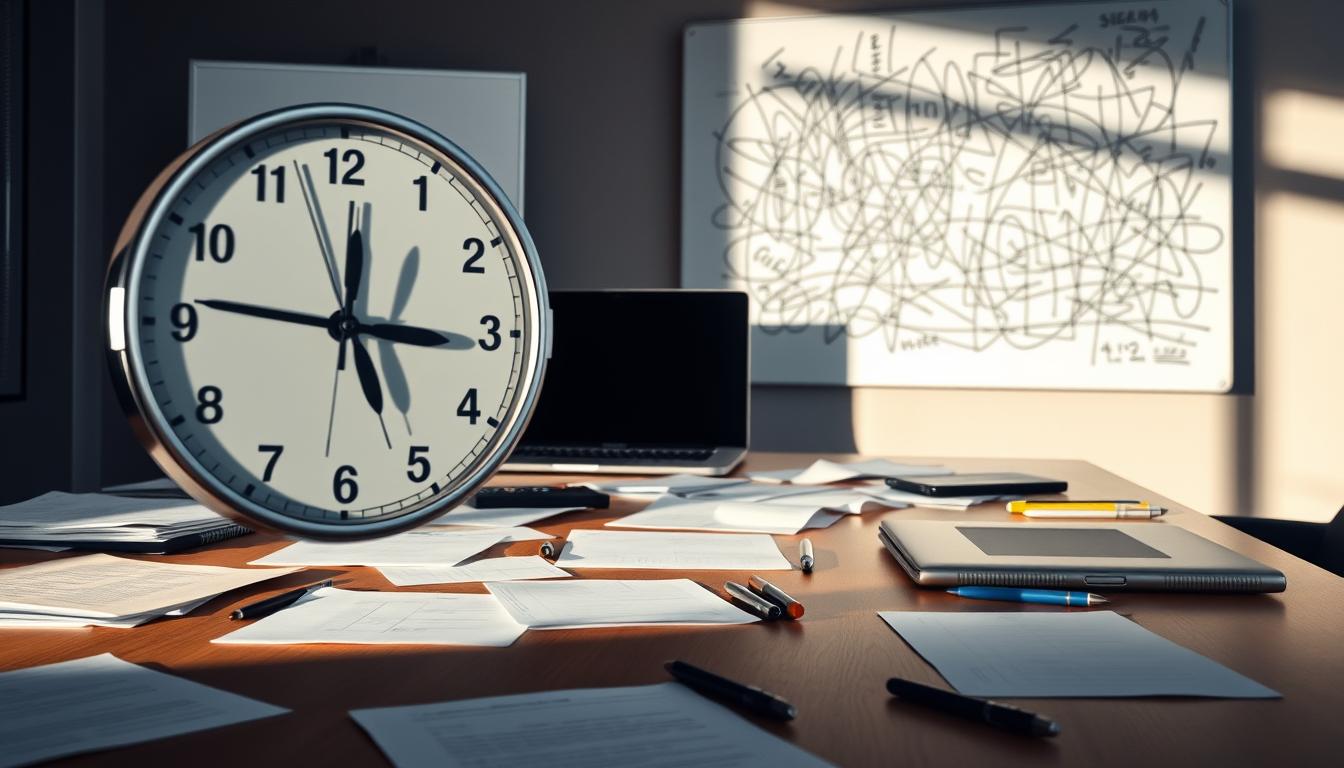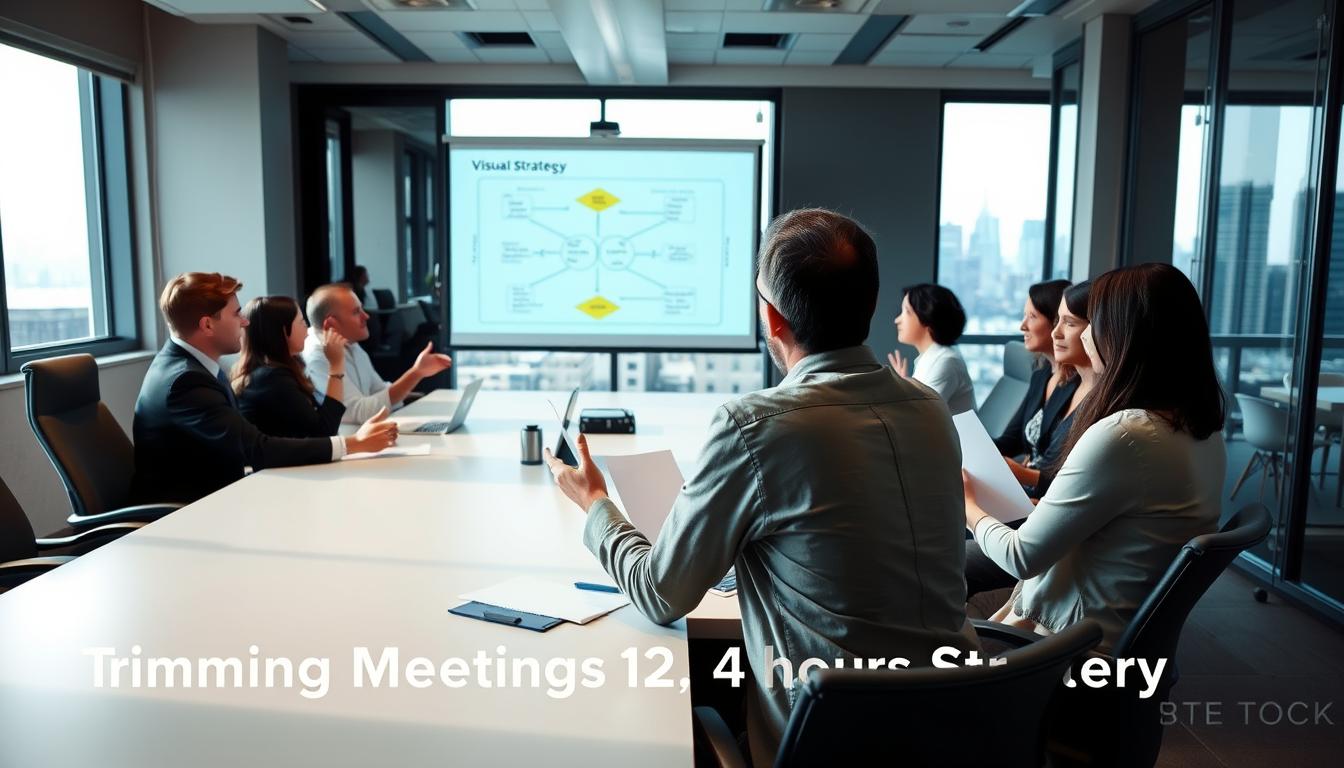In the busy world of business, running efficient meetings is crucial. Effective meeting agendas can make a big difference, helping teams concentrate on important topics. They offer clear direction, show what’s expected, and guide fruitful talks.
Using a planned method, companies can cut down on wasted time. This creates a space where everyone feels they can share their thoughts.
The Importance of Meeting Agendas
A well-planned agenda is key to effective meetings. It makes sure everyone knows what will be talked about. This organization not only helps run the meeting smoothly but also makes it productive. Everyone feels like they belong and know what’s happening.
Setting Clear Expectations
Knowing what a meeting will cover lets people get ready. This readiness leads to better talks. It makes sure we’re all going the same direction. Clear goals cut down on confusion and keep talks focused. This makes the meeting more efficient.
Driving Productive Discussions
Agendas are crucial for keeping discussions on track. They help keep the conversation relevant and aimed at our goals. Without one, meetings can wander off, making people frustrated. A set structure promotes responsibility. It lets everyone share their thoughts. This leads to outcomes that matter.
Understanding the Costs of Ineffective Meetings
Ineffective meetings hurt organizations by lowering productivity and making employees unhappy. When meetings are disorganized, a lot of time is wasted, leading to big financial losses. Understanding the impact on resources and employee morale is critical.
Wasted Time and Resources
Ineffective meetings can be very costly, with some estimates showing losses of $37 billion a year across businesses. Companies often get stuck in pointless meetings, which means lost productivity and delayed decisions. Directionless meetings make this worse, hurting the company’s efficiency.
Impact on Employee Morale
Poorly planned meetings make team members feel like their time doesn’t matter, which is frustrating. Without results from meetings, employees start to disconnect, damaging the meeting culture. This drop in morale leads to less teamwork and lower job happiness.
Why Your Team Needs an Agenda for Every Meeting
Having an agenda for every meeting helps teams work better. It keeps everyone focused and involved. This way, teams can go through topics without getting lost.
Improving Clarity and Focus
Agendas make goals clear from the start. This lets everyone get ready and share more useful ideas. Being prepared means people can join the discussion and make it richer.
Encouraging Preparedness Among Participants
Sharing an agenda early lets people prepare. Everyone can look up info or bring what they need for the topics. This effort makes discussions better and shows being ready is important.
Promoting Accountability
An agenda keeps meetings on track and follows up on tasks. It makes sure what’s promised is done later. Having such accountability helps teams get real results and move forward.
Key Elements of an Effective Meeting Agenda
Creating an effective meeting agenda is key to keeping productivity high. It ensures that talks stay on point. By focusing on certain elements, we can direct the meeting and manage our time better. This organized method helps everyone involved.
Clear Objectives
Having clear goals is the start of a successful meeting. These goals show what the meeting hopes to accomplish. Everyone gets more involved when they understand the aims. This focus on goals keeps discussions right on track.
Specific Discussion Points
Adding specific points to talk about keeps the meeting moving smoothly. It helps avoid getting sidetracked and makes sure each topic is covered well. This way, we avoid unnecessary side talks and achieve more effective results.
Time Allocations for Each Item
It’s important to decide how long to spend on each item on the agenda. This method stops one topic from taking up too much time. It allows everyone to contribute evenly. Keeping an eye on the clock helps the meeting stay productive and dynamic.
Best Practices for Creating Meeting Agendas
Effective meetings start with well-made agendas. Having the best practices for agendas boosts productivity and keeps talks on track. Key strategies can make agendas better and ensure smooth meetings for everyone.
Standardizing Agenda Formats
Using a standard format for meeting agendas helps keep things consistent. It makes prep and discussion easier when everyone knows the layout. This consistency sets expectations and helps people move smoothly from one meeting to the next.
Inviting Participant Input
Asking for input from participants makes agenda drafting collaborative. Including topics or concerns from the team ensures all key issues are covered. This approach not only boosts engagement but also lets team members help set the meeting’s goals.
Sharing Agendas in Advance
It’s important to send out agendas before the meeting, ideally 24-48 hours ahead. This gives everyone enough time to look over materials and think about their input. Hence, meetings start with everyone ready and focused on shared objectives.
How to Validate Your Meeting Agenda
Checking a meeting agenda means making sure it fits the meeting goals. This step is key to help everyone know what to expect and how they can help. By looking over the agenda carefully, we can find the main goals and important points to talk about. This leads to results that we can actually do.
Ensuring Alignment with Meeting Goals
To make sure your agenda is right, first check if each part helps meet your goals. You might ask yourself important questions like:
- Does this item help us reach our objectives?
- Have we included all important people in this discussion?
- Will talking about this lead to important decisions or steps?
By doing this, you can cut out things that don’t help and make the discussion more useful.
Identifying Actionable Outcomes
After making sure everything matches the goals, it’s vital to know what you want to achieve with each agenda item. This makes the talks lead to real steps we can follow. Think about these steps:
- Decide what success in the meeting means.
- List the specific steps or choices we need to make.
- Give people tasks so we know who does what after the meeting.
Using these steps helps teams make agendas that work. They focus on the important stuff while making sure everyone knows their part. This builds a team where everyone knows what they’re supposed to do.
Measuring Agenda Effectiveness
It’s important to measure how well agendas work in meetings. This helps check if meetings stay focused and achieve their goals. When meetings stray from their plan, time gets wasted and problems don’t get solved. This makes the meeting less useful.
Tracking Agenda Adherence
To see if meetings follow the agenda, you should:
- Look at how much time each topic takes
- Notice when talks go off-track
- Ask attendees if the topics were relevant
This helps figure out if the agenda is really guiding the meeting. It keeps things on track and efficient.
Assessing Decision-Making Rates
Checking how well decisions are made is also key. Businesses need to see if meetings lead to clear actions. Here’s what to do:
- Write down what decisions are made
- Make sure action items are clear
- Get feedback from attendees on the agenda’s usefulness
This way, companies can tell if the agenda helps make useful decisions. It ensures meetings are worth the time.
Strategies to Ensure Time Management During Meetings
To manage time well in meetings, focus on two main things: setting aside a certain amount of time for each item on your agenda and using facilitators. Doing this helps teams be more productive and keeps talks about topics on track.
Allocating Time for Each Agenda Item
It’s crucial to give each agenda item a specific time slot. This helps everyone stay focused and participate well. With this method, meetings run smoothly because:
- All subjects get discussed within the planned time.
- Conversations stay short and to the point.
- Meetings begin and end as scheduled, which respects everyone’s time.
Using Facilitators to Keep Discussions on Track
Having a facilitator is key to managing time in meetings well. They steer the conversation, ensuring that:
- No single topic takes over the whole meeting.
- Everyone gets a chance to talk while staying on topic.
- The discussion moves back on track if it starts to wander.
Creating a Culture of Structured Meetings
Creating a culture with structured meetings is key for success. Getting team members to help with participation in agenda setting makes them feel part of the process. They become more engaged and responsible. This leads to better talks and results.
Encouraging Participation in Agenda Setting
Teams that help set agendas care more about the results. Adding different views leads to deeper discussions. Everyone gets to share what’s important to them. This teamwork makes the importance of agendas clear to all. Knowing why meetings happen makes them more effective.
Reinforcing the Importance of Agendas across Teams
It’s crucial to show why agendas matter to every team. Workshops and training highlight the benefits of organized meetings. These efforts teach everyone the value of a good meeting setup. It boosts productivity across the board.

Utilizing Technology to Enhance Meeting Agendas
Today’s work world moves fast, making tech for meeting agendas key to better meetings. Advanced tools help make things smooth, keeping everyone on track and engaged.
Enforcing Agenda Policies with Calendar Tools
Calendar apps are crucial for organizing meetings well. They make sure agendas are shared before invites, which helps everyone know what to expect. Good calendar tools have:
- Mandatory agenda fields for meeting invites
- Accessibility from multiple devices
- Automated reminders for agenda distribution
Implementing Meeting Analytics Software
Meeting analytics software is a game-changer for making meetings better. It looks at things like how well everyone sticks to the agenda and how much they participate. These tools can bring major improvements by showing:
- Understanding engagement rates among participants
- Assessing the effectiveness of agenda items
- Driving continuous improvement based on data trends
Conclusion
Meeting agendas are super important. They make meetings more effective and help everyone stay on track. By using good practices for creating agendas, teams can make sure everyone is ready and focused.
Also, checking if agendas work well leads to better time use and less waste. This helps build a responsible and involved team culture. Keeping focus on organized agendas makes workplaces run smoother.
When companies understand how crucial agendas are, they work better together. Every meeting has a clear goal. In short, good use of meeting agendas brings big benefits for any group wanting to do its best.



